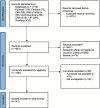Research on the mechanism of core acupoints in electroacupuncture for functional constipation based on data mining and network acupuncture
- PMID: 39722820
- PMCID: PMC11669256
- DOI: 10.3389/fmed.2024.1482066
Research on the mechanism of core acupoints in electroacupuncture for functional constipation based on data mining and network acupuncture
Abstract
Aim: Functional Constipation (FC) is a common gastrointestinal disorder that imposes a considerable strain on global health. It negatively impacts the quality of life and results in significant healthcare expenditures. Current treatments, such as lifestyle changes and medications, fail to meet patient satisfaction due to efficacy and safety issues. Electroacupuncture (EA), with its precise stimulation control and standardized protocols, shows promise in FC management. However, optimal EA parameters for FC treatment are yet to be established. Our study reviews EA applications in FC to inform a standardized treatment approach and explore EA's therapeutic mechanisms.
Methods: This comprehensive study utilized research literature from databases including PubMed, Embase, OVID, Web of Science, the Cochrane Library, CNKI, VIP, and Wanfang to perform a descriptive analysis of acupoint selection and EA parameters. It proceeded to analyze high-frequency acupoint groupings and stimulus parameters, followed by the excavation and analysis of core acupoint prescriptions. Subsequent steps integrated potential target identification for these core formulas, the assembly of a "core acupoint-prescription-target-constipation" network, and the construction of a protein-protein interaction (PPI) network to extract central targets. Additionally, Gene Ontology (GO) and KEGG enrichment analyses were conducted to prognosticate the underlying mechanisms by which EA may exert its therapeutic effects on FC.
Results: In our study, we analyzed 141EA prescriptions for FC and identified a core set of acupoints including Tianshu (ST25), Fujie (SP14), Shangjuxu (ST37), and Zusanli (ST36) through data mining. The frequency of use was highest for Tianshu (ST25) with 119 occurrences, followed by Fujie (SP14) with 59, Shangjuxu (ST37) with 42, and Zusanli (ST36) with 23. PPI network analysis revealed key targets such as NFKB1, IL6, MyD88, TLR4, TNF, TLR2, and IL1B. GO and KEGG analyses of 49 constipation-associated targets identified 257 BP, 37 CC, and 41 MF terms, and 154 significant pathways, with the top 20 visualized for further analysis.
Conclusion: The core acupoint prescription of EA for FC can exert its therapeutic effects by acting on multiple targets and pathways synergistically especially on NFKB1, IL6, MyD88, TLR4, TNF, TLR2, and IL1B. The research findings have preliminarily validated the fundamental effects and related mechanisms of EA parameters and core prescriptions, providing direction for further in-depth exploration of the mechanisms of action.
Keywords: Functional Constipation (FC); association analysis; data mining; electroacupuncture; network acupuncture.
Copyright © 2024 Ong, Tang, Xu, Xu, Li, Deng, Shen, Chen, Song, Lu and Fang.
Conflict of interest statement
The authors declare that the research was conducted in the absence of any commercial or financial relationships that could be construed as a potential conflict of interest.
Figures





Similar articles
-
[Network visual data mining and analysis of literature on electroacupuncture treatment of post-stroke sequelae].Zhen Ci Yan Jiu. 2023 May 25;48(5):508-14. doi: 10.13702/j.1000-0607.20220096. Zhen Ci Yan Jiu. 2023. PMID: 37247866 Review. Chinese.
-
Rules of acupoint selection in treatment of inflammatory bowel disease with acupuncture-moxibustion based on complex network analysis.Zhen Ci Yan Jiu. 2024 Mar 25;49(3):315-323. doi: 10.13702/j.1000-0607.20221382. Zhen Ci Yan Jiu. 2024. PMID: 38500330 Chinese, English.
-
[Analysis of mechanism of core points in acupuncture and moxibustion treatment for epilepsy based on data mining].Zhen Ci Yan Jiu. 2024 Apr 25;49(4):415-423. doi: 10.13702/j.1000-0607.20230019. Zhen Ci Yan Jiu. 2024. PMID: 38649211 Chinese.
-
Analysis of Electroacupuncture Parameters for Irritable Bowel Syndrome: A Data Mining Approach.J Pain Res. 2025 Apr 23;18:2175-2189. doi: 10.2147/JPR.S483750. eCollection 2025. J Pain Res. 2025. PMID: 40290613 Free PMC article.
-
[Regularities of acupoint combinations and characteristics of core acupoint application for acupuncture-moxibustion treatment of mammary gland hyperplasia based on complex network analysis].Zhen Ci Yan Jiu. 2021 Jan 25;46(1):76-83. doi: 10.13702/j.1000-0607.200696. Zhen Ci Yan Jiu. 2021. PMID: 33559431 Review. Chinese.
Cited by
-
Unraveling the mechanism of core prescription in primary liver cancer: integrative analysis through data mining, network pharmacology, and molecular simulation.In Silico Pharmacol. 2025 Apr 16;13(2):63. doi: 10.1007/s40203-025-00352-2. eCollection 2025. In Silico Pharmacol. 2025. PMID: 40255256
-
The Mechanism of Acupuncture Regulating Autophagy: Progress and Prospect.Biomolecules. 2025 Feb 11;15(2):263. doi: 10.3390/biom15020263. Biomolecules. 2025. PMID: 40001566 Free PMC article. Review.
References
Publication types
LinkOut - more resources
Full Text Sources
Miscellaneous

